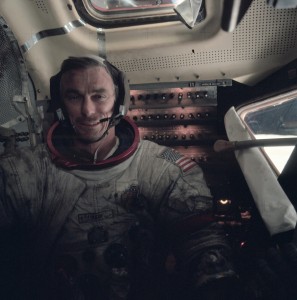By Henry M. Holden
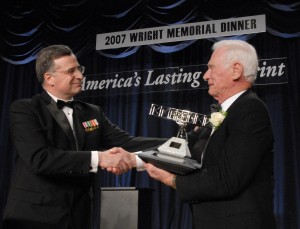
Jonathan Gaffney, National Aeronautics Association president, presents the Wright Brothers Memorial Trophy to Capt. Eugene A. Cernan.
Capt. Eugene A. Cernan is the latest recipient of the National Aeronautic Association’s Wright Brothers Memorial Trophy. Cernan was honored with the award on Dec. 14, 2007, 35 years to the date he became the “last man on the moon.” More than 900 people attended the Aero Club of Washington’s Annual Wright Brothers Memorial Dinner at the Washington Hilton.
Paula Hochstetler, president of the Aero Club of Washington, co-hosted the black-tie event. Ed Hazelwood of Aviation Week magazine acted as the initial MC, doing a powerful reading of the poem “High Flight,” written by John Gillespie Magee Jr.
NAA established the award in 1948 to honor the memory of Orville and Wilbur Wright. The trophy is given each year on or near the anniversary of their historic first flight. It’s awarded to a living American for “significant public service of enduring value to aviation in the United States.” The award is one of the most prestigious aviation trophies in the world; previous winners include Charles Lindbergh, Igor Sikorsky, Juan Trippe, Sen. Barry Goldwater, Kelly Johnson, Herb Kelleher, Neil Armstrong, Sen. John Glenn and many other top industry leaders.
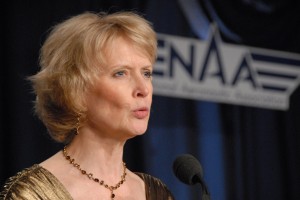
Paula Hochstetler, president of the Aero Club of Washington, co-hosted the black-tie event with the NAA.
Cernan was one of 14 astronauts selected by NASA in October 1963, and he is one of two men to have flown to the moon on two occasions. He occupied the pilot seat alongside command pilot Tom Stafford on the Gemini 9 mission, a three-day flight that began on June 3, 1966.
“As a pilot on Gemini 9, Cernan became the second American to walk in space, where he spanned the circumference of the world twice in a little more than two and a half hours,” said
Jonathan Gaffney, president of NAA and chairman of the selection committee.
Cernan subsequently served as backup pilot for Gemini 12 and as backup lunar module pilot for Apollo 7. On his second space flight, Cernan was LM pilot of Apollo 10, May 18-26, 1969.

Ed Hazelwood of Aviation Week magazine used his deep baritone voice to deliver a dramatic reading of “High Flight,” by John Gillespie Magee Jr.
“What probably could be considered the greatest dress rehearsal of all time was Apollo 10, where Cernan and his crewmates confirmed the performance and reliability of the entire Apollo system, as they flew the lunar module to within eight miles of the lunar surface,” Gaffney said.
His next assignment was backup spacecraft commander for Apollo 14. He made his third space flight as spacecraft commander of Apollo 17, departing Earth on Dec. 6, 1972. With him on the voyage of the command module America and the lunar module Challenger were Ronald Evans, CM pilot, and Harrison H. (Jack) Schmitt, LM pilot.
The dinner served as a poignant evening for Cernan, who spoke emotionally about the fact that his were most likely the last human footsteps on the moon. He talked about his “temporary home” in deep, personal terms, describing the Apollo 17 landing site as “a deep valley, deeper than the Grand Canyon” and reminiscing about standing on the surface of the moon, seeing Earth suspended, turning in space, “its blue seas and white clouds visible in the palpable blackness.”
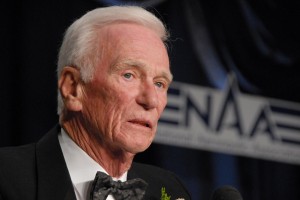
While Gene Cernan didn’t characterize his experience on the moon as a religious awakening, it had a profound effect. He described space as a three-dimensional blackness.
“Gene mentioned the blackness of space many times, characterizing it as a three-dimensional blackness,” Boyne said. “While he didn’t explicitly characterize his experience as a religious awakening, you certainly got the sense of his awe at the precision and the beauty of the universe.”
Walter Boyne, chairman of NAA, said Cernan accepted the award with a touching humility.
“He was obviously very moved,” he said. “The atmosphere was extremely uplifting. He saluted his wife and his family members, with five of his nine grandchildren leaping from their chairs, waving in delight.”
Apollo 17 established several new records for manned space flight.
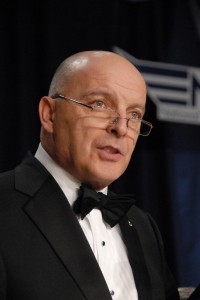
Bob Agostino, Bombardier director of flight operations, delivered an uplifting speech about Gene Cernan and introduced a video of Cernan’s life.
“I always think of the missions of Apollo as the world’s greatest adventure,” said Jonathan Gaffney, president of NAA and chairman of the selection committee. “Apollo 17 wasn’t the most dangerous mission. Jim Lovell and the Apollo 13 crew—and later, Tom Hanks, in the movie—had us praying for days in 1970. Nevertheless, Capt. Cernan’s flight was certainly the most productive. In three days on the moon, he drove his lunar rover 21.3 miles, which is equivalent to driving from Washington D.C. to Reston, Va. The mission also included the longest manned lunar landing flight (301 hours, 51 minutes), the longest lunar surface extravehicular activities (22 hours, 6 minutes), the largest lunar sample return (an estimated 244 lbs) and longest time in lunar orbit (147 hours, 48 minutes).”
Cernan clearly understood the importance and prestige of the Wright Trophy, as the 60th honoree.
“It was clear he was aware that his efforts were part of a great team,” said Boyne. “But he was also aware that his father’s admonition to ‘always do your best’ had paid off for him in a remarkable way, putting him in a pantheon of unequalled importance in the industry. Cernan gave a clarion call for the next generations to do their best and to keep the spirit of space exploration alive and well.”
Boyne said that judging from the audience’s reaction, NAA made the correct decision in naming Cernan to receive the Wright Trophy.
“We had many commendable nominations for this great trophy, but Capt. Cernan’s lifetime of achievement made him a very worthy choice,” Gaffney said.

Eugene Cernan salutes the flag during extravehicular activity on NASA’s final lunar landing mission.
As a naval officer, Cernan logged more than 5,000 hours flying time, with 4,800 hours in jet aircraft and 200 carrier landings. As an astronaut, he logged 566 hours and 15 minutes in space, of which more than 73 hours were spent on the moon’s surface. In September 1973, Cernan assumed additional duties for NASA, on the development and evaluation of the joint U.S./Soviet Union Apollo-Soyuz Test Project. He acted as senior U.S. negotiator for the program manager, in direct discussions with the USSR.
On July 1, 1976, he retired after more than 20 years with the Navy and ended his formal association with NASA. In September 1981, he started his own company, The Cernan Corporation, to pursue management and consultant interests in energy, aerospace and other related industries. He’s been actively involved as a co-anchorman on ABC TV’s presentations of space shuttle flights. He’s currently chairman of the board for Johnson Engineering Corporation.
Cernan’s honors and awards include the Master Pilot Award from the Federal Aviation Administration and induction into the National Aviation Hall of Fame, Naval Aviation Hall of Fame and U.S. Space Hall of Fame. He also received two NASA Distinguished Service Medals, the NASA Exceptional Service Medal, Joint Chiefs of Staff Superior Achievement Award, two Navy Distinguished Service Medals, the Navy Astronaut Wings and Navy Distinguished Flying Cross, the National Academy of Television Arts and Sciences Special Trustees Award and the Fédération Aéronautique Internationale Gold Space Medal for 1972.
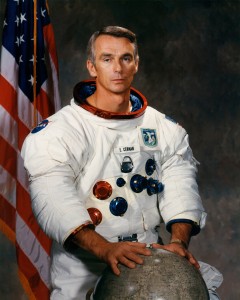
As a naval officer, Gene Cernan logged more than 5,000 hours flying time, with 4,800 hours in jet aircraft and 200 carrier landings. As an astronaut, he logged 566 hours and 15 minutes in space, of which more than 73 hours were spent on the moon’s surface
The National Aeronautic Association is the official keeper and certifier of air and space records. Other NAA awards include the Frank G. Brewer Trophy, Elder Statesman Award and Cliff Henderson Award.
Gene Cernan’s biography is available in “The Last Man on the Moon,” by Cernan and Don Davis. He’s also featured in “Living Legends of Aviation,” by Di Freeze, which will be available to the public this year. For more information about NAA, visit [http://www.naa.aero].












